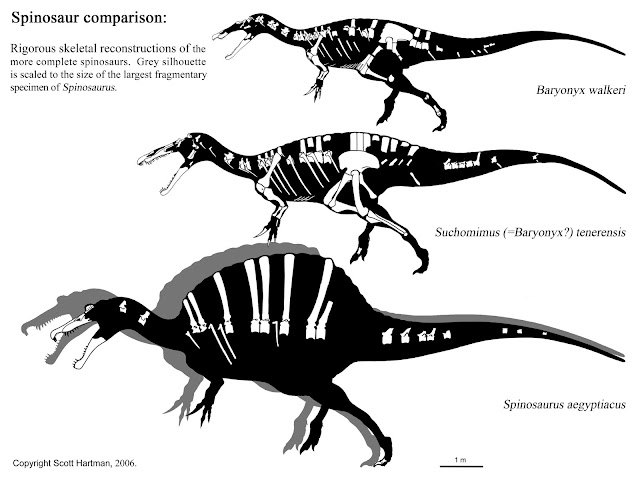Scott Hartman does wonderful things and today, this image, is exactly what we are looking for. Not only does it present the known remains of Suchomimus, our dinosaur in question this week, but it also shows the known evidence of its extended family. The skulls alone are very good examples of why these three animals have been placed in the same lineage. "Lumpers", those in favor of placing fossil specimens in as few species as possible through comparisons between currently separated species, could use these sets of remains to make a rather strong argument for a growth series, given only the amount and types of bones that exist and comparing them to one another. The major difference between the three that would be most difficult to reconcile would of course be the dorsal neural spines of Spinosaurus. The skulls are all similarly shaped, however, and the hands and forelimbs that we have for Baryonyx as well as Suchomimus are very similar. Hindlimb evidence is missing for Spinosaurus and Baryonyx, though we have a very little amount of Baryonyx material, whereas it is quite well documented in Suchomimus; pelvic elements of Suchomimus and Baryonyx are well represented. The majority of the vertebrae are absent in all three species and ribs and gastralia are only well evidenced in Suchomimus though some do exist in association with Baryonyx remains.
The first thing anyone notices with regard to Spinosaurs like Baryonyx and Subhomimus is the posture. The reason that people always notice the posture is because it is always the same in mounted specimens, casts, and models. Hindlimbs are slightly bent, tail straight out, torso angled downward and forward, with the mouth agape and the forelimbs splayed open, palms of the hands facing one another. The constantly used posture leads to confusion over the type of animal on display. Baryonyx being more widely known than Suchomimus, many Suchomimus skeletons are misnamed and mistaken as Baryonyx. Similar posture as well as similar body composition probably means similar behavior and diet.



No comments:
Post a Comment